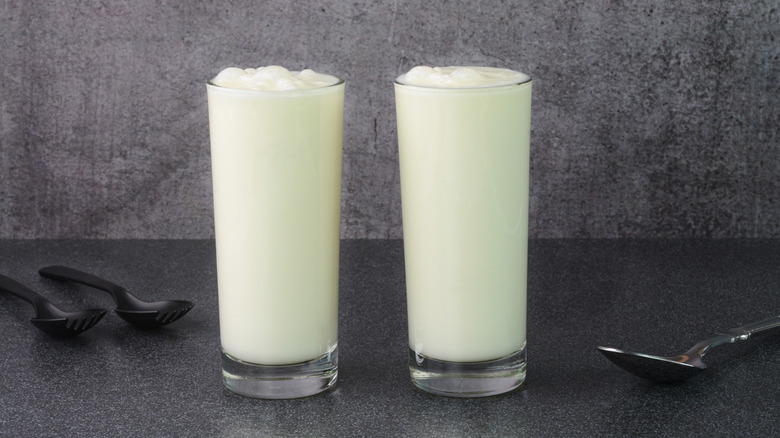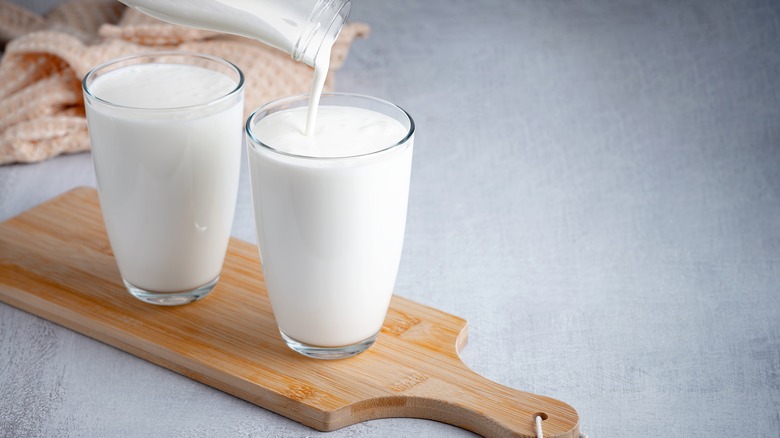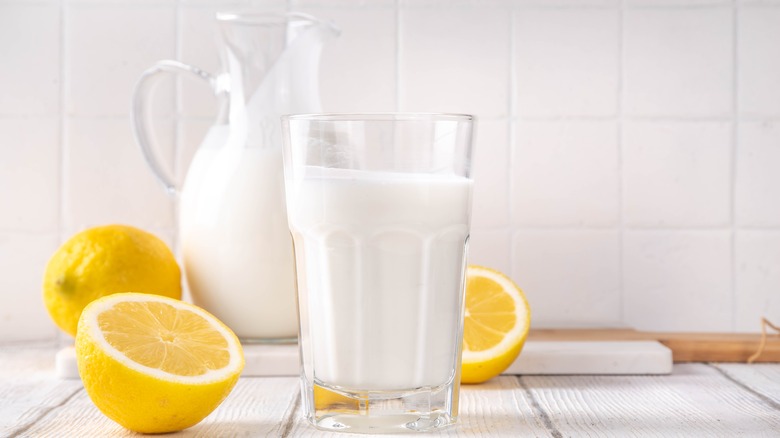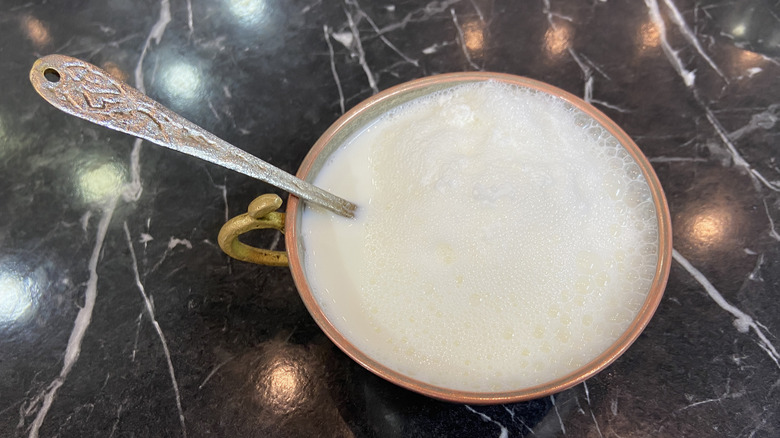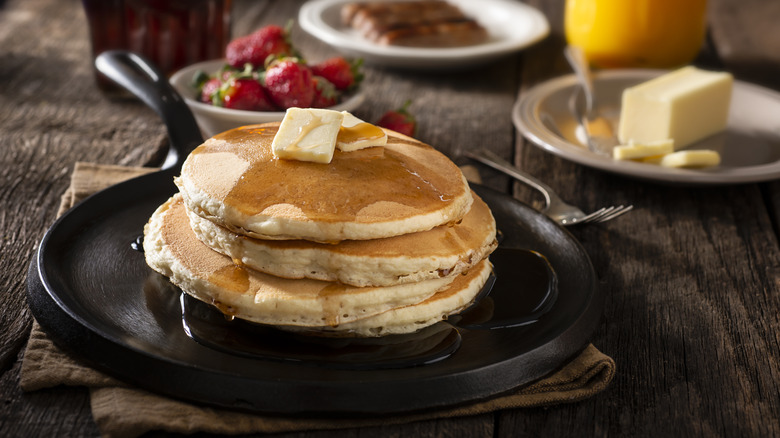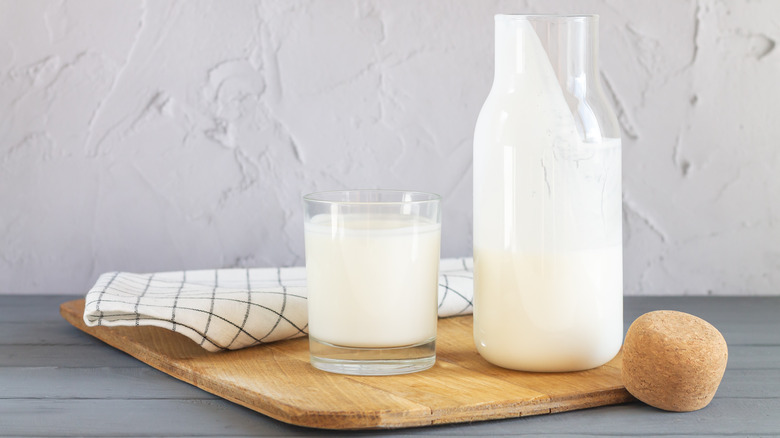The Major Differences Between Store-Bought Buttermilk And Homemade
It's happened to all of us — you're in the middle of a recipe, everything's going smoothly, and suddenly, you realize it calls for buttermilk. Not milk, which you have a nearly full gallon of in the fridge, but buttermilk. Thankfully, the recipe writer comes to the rescue with a helpful tip — you can avoid an emergency grocery run and make the buttermilk yourself at home by mixing a splash of lemon juice or white vinegar with ordinary milk.
But is your homemade sour milk concoction really the same thing as buttermilk? Unfortunately, it's not even close, but it will work in a pinch, at least for some recipes. Keep reading to learn the differences between store-bought buttermilk and its homemade substitute, when you should stick with the real thing (even if it means an extra trip to the store), and how you can make real buttermilk at home.
What is store-bought buttermilk?
Buttermilk is a cultured milk product commonly used in baking, cooking, drinks, and desserts. It's thicker than milk and cream, with a tanginess like plain yogurt and kefir. It's commonly used to tenderize chicken before frying, leaven quick breads like pancakes and cornbread, and to add richness to salad dressings, smoothies, and ice cream.
Originally, buttermilk was a byproduct of churning butter (hence the name "buttermilk"). Butter makers would allow fresh cream to sit at room temperature for 24 hours, during which time ambient bacteria and bacteria present in the milk would begin to ferment it, much like yogurt and sourdough starter. Buttermilk, the cultured whey left behind after churning the butter, would be poured off and bottled. It was naturally fat-free, as all the fat had been churned off into butter, and had a longer shelf life than raw milk, which was a major benefit in the days when refrigeration was a challenge.
Modern store-bought buttermilk is made a little differently. Instead of whey, commercial buttermilk is made from cultured milk and can be full-fat, skim, or anything in between, but is usually made with low-fat milk. Though whey is still a byproduct of the cheesemaking process, demand for buttermilk has declined over the years, and dairy producers have realized that they can make more profit using the whey to make ice cream and whey protein for the baking industry while using ordinary milk to make the necessary amount of buttermilk.
What is homemade buttermilk?
What most recipes describe as "homemade buttermilk" is actually soured milk, a buttermilk substitute. It's typically made by adding a tablespoon of white vinegar or lemon juice to one cup of milk and allowing it to sit briefly to curdle. The resulting mixture is acidic and slightly sour, with noticeable milk solids separated from the whey. The acidity and sourness roughly mimics store-bought buttermilk, allowing it to stand in as a reasonable substitute for those times when you don't realize you'll need it until it's too late to go out and buy it.
Making true buttermilk at home is possible, but it requires a lot more time, effort, ingredients, and, depending on the method you choose, equipment. You can seed ordinary milk with live, active cultures (such as those found in yogurt or store-bought buttermilk) and allow it to ferment for 24 hours or more, or churn cultured heavy cream, pouring off the buttermilk after the butter forms (or "comes," in butter-making terms). But when most recipes offer "homemade buttermilk" as a substitute for store-bought, it's just soured milk.
Store-bought buttermilk is better for you
The primary difference between store-bought buttermilk and a homemade buttermilk substitute is that store-bought buttermilk is cultured using live active cultures in a controlled environment to produce a consistent product. In contrast, homemade buttermilk is rapidly soured using vinegar or lemon juice at home. So, while both are sour, slightly lumpy milk products, their properties and best uses are actually very different.
For example, store-bought cultured buttermilk has similar gut health benefits to other fermented foods like kefir and kimchi, and the fermentation process breaks down lactose in the milk, making buttermilk easier to stomach for people who are lactose intolerant. Adding lemon juice or vinegar to milk, on the other hand, only acidifies and curdles the milk, which doesn't break down lactose. And even if it did, good luck drinking it — acidifying milk is the first step in making cheese, and drinking soured milk is about as appetizing as drinking a glass full of ricotta cheese curds floating in whey (which is exactly what it is).
Store-bought buttermilk is better for baking
You'll often find homemade soured milk as a recommended substitute for store-bought buttermilk in recipes for things like quick breads and pancakes, so it may surprise you to learn that it may actually be throwing off your baked goods. For one thing, homemade buttermilk substitute is thinner than store-bought, which means any batter you use it in will be thinner than if you used the real thing, which could lead to gooey, flat-topped breads.
Using soured milk instead of buttermilk can also ruin the rise of your baked goods. Most baking recipes that call for buttermilk include baking soda, an alkaline ingredient that requires acid to activate. Since store-bought buttermilk is cultured in a controlled environment, you can generally count on a consistently acidic pH across buttermilk brands. Soured milk, on the other hand, may vary in acidity depending on the acid used to curdle it. The pH of lemons, for example, can range from two to three, while white vinegar is about 2.5.
This means that three soured milks made from white vinegar and juice from two different lemons could potentially have three different pH measurements. If your ratio of acid to milk varies even a little bit, that could alter the balance even more. A small change in acidity can have a huge impact on how your baked goods rise, so while soured milk may work in a pinch, it's best to go with real, store-bought buttermilk when you're baking.
Store-bought buttermilk may contain added flavors, preservatives, and thickeners
Because today's commercially-produced buttermilk is typically made from cultured low-fat milk, not cream, as it was in the past, it's thicker than ordinary milk but not as thick as old-fashioned churned buttermilk. This discrepancy can affect the texture of anything you make with it, especially in an older recipe that calls for churned buttermilk. Producers often add thickening ingredients, along with flavors and preservatives, to compensate. For example, Kroger Cultured Low-Fat Buttermilk contains modified corn starch, tapioca starch, guar gum, locust bean gum, and carrageenan.
Homemade buttermilk substitute doesn't have any of that — just milk and vinegar or lemon juice — but it also doesn't have the tang or creamy texture of cultured buttermilk. If you want all the benefits of real buttermilk without the added flavors, thickeners, and preservatives, you can usually find it at Whole Foods or any other natural foods store. Or, if you have some time to spare, you can make your own at home with regular milk and a cultured starter like plain yogurt with live active cultures, kefir, or leftover store-bought buttermilk.
Simply mix 1-4 tablespoons of your chosen starter — experiment to find the exact ratio you prefer — per cup of milk. Cover lightly and let it sit on your counter at room temperature for 10-24 hours. If you make just a few tablespoons more than you need, you can even use your home culture to start your next batch of buttermilk.
